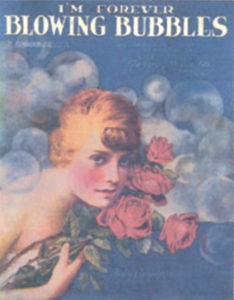 Compiled by Peggy DeStefano
Compiled by Peggy DeStefano I remember my father singing numerous little ditties and great old songs. That, plus the fact that we owned a player piano, helped make my brothers and sisters and I knowledgeable of all of the classic honkey tonk songs. There was “Margie,” which my Dad sang to my Mom, changing Margie to my Mom’s name when he sang to her. There was ‘If You Knew Suzy,” ‘5’2” Eyes of Blue,” ‘Ida, Sweet as Apple Cida,” “Barney Google,” “A Bicycle Built for Two” and many more which we delighted in singing while we did dishes or other chores.
One of my Dad’s favorites was “I’m Forever Blowing Bubbles.” We all learned this song because it became one of our favorites, too. It is hard to believe that this song is over 100 years old and yet I’d venture to say it is still a favorite of many people including my family.
The song debuted in a Broadway musical “The Passing Show of 1918” and it was introduced by Helen Carrington. It was written by John Kellette. The lyrics are credited to Jaan Kenbrovin — actually a pseudonym for the writers James Kendis, James Brockman and Nat Vincent. The copyright was originally registered in 1919 and owned by Kendis-Brockman Music Co. and then transferred later that year to Jerome Remick of New York and Detroit.
The “waltz” was a major Tin Pan Alley hit and was performed and recorded by most major singers and bands of the late 1910s and early 1920s. The song was a hit for Ben Selvin’s Novelty Orchestra in 1919. The Original Dixieland Jass Band recording of the number is an unusual early example of jazz in ¾ time.
(Jass is the word that was used before jazz but became Jazz eventually. The original word was used to describe baseball players with pep. “Livery Stable Blues — Fox Trot” was the recording that turned the whole USA and the world to jazz.)
The writer Ring Lardner parodied the lyric during the Black Sox scandal of 1919, when he began to suspect that players on the Chicago White Sox were deliberately losing the World Series to the Cincinnati Reds. His version began: “I’m forever blowing ballgames.”
 The song also became a hit with the public in British music halls and theatres during the early 1920s. Dorothy Ward was especially renowned for making the song famous. The song was also used by English comedian “Professor” Jimmy Edwards as his signature tune—played on the trombone. Harpo Marx would play the song on clarinet, which would then begin emitting bubbles. The melody is frequently quoted in animated cartoon sound tracks when bubbles are visible. The first line of the chorus is quoted in the 1920s song “Singing in the Bathtub,” also a popular standard in cartoon sound tracks, including being repeatedly sung by Tweety Bird.
The song also became a hit with the public in British music halls and theatres during the early 1920s. Dorothy Ward was especially renowned for making the song famous. The song was also used by English comedian “Professor” Jimmy Edwards as his signature tune—played on the trombone. Harpo Marx would play the song on clarinet, which would then begin emitting bubbles. The melody is frequently quoted in animated cartoon sound tracks when bubbles are visible. The first line of the chorus is quoted in the 1920s song “Singing in the Bathtub,” also a popular standard in cartoon sound tracks, including being repeatedly sung by Tweety Bird. “I’m Forever Blowing Bubbles” is featured extensively in the 1930 prohibition gangster movie The Public Enemy starring James Cagney. It also was sung by a white bird in the Merrie Melodies cartoon I Love to Singa. The song is also sung in the 1951 movie On Moonlight Bay starring Doris Day and Gordon MacRae, which was a prequel to the 1953 film By the light of the silvery moon.
A parody of the song was written and performed as “I’m Forever Blowing Bubble-Gum” by Spike Jones and his City Slickers. In Ken Russell’s 1969 film Women in Love the song is featured in an unusual scene where two sisters, played by Glenda Jackson and Jennie Linden, wander away from a large picnic gathering and are confronted by a herd of cattle. In 1970, The Bonzo Dog Band’s stage show featured a robot that sang the title while blowing bubbles. A solo guitar rendition is periodically featured within the action of Woody Allen’s 1999 film Sweet and Lowdown. Director Brad Mays paid homage to that scene in his 2008 film The Watermelon, in which actress Kiersten Morgan sings the song while dancing on a Malibu beach.
 The song itself inspired many good deeds and outcomes. At the 1930 Shriners International Imperial Session Imperial Potentate Freeland Kendrick proposed a unified charitable mission for the Shriners fraternity by building an orthopedic hospital for children. The idea came to him after visiting every Shriners temple in the United States and seeing their individual charitable projects. While visiting Texas, he discovered the Scottish Rite Hospital for Crippled Children which primarily treated children suffering the devastating effects of polio. He was shocked to learn that there were not enough hospitals specializing in care for children, especially those suffering from polio.
The song itself inspired many good deeds and outcomes. At the 1930 Shriners International Imperial Session Imperial Potentate Freeland Kendrick proposed a unified charitable mission for the Shriners fraternity by building an orthopedic hospital for children. The idea came to him after visiting every Shriners temple in the United States and seeing their individual charitable projects. While visiting Texas, he discovered the Scottish Rite Hospital for Crippled Children which primarily treated children suffering the devastating effects of polio. He was shocked to learn that there were not enough hospitals specializing in care for children, especially those suffering from polio. When he made the proposal at the 1920 convention, many of the more conservative Shriners expressed doubts, both about the annual (two-dollar assessment), and the long term viability and responsibility of taking on such a mission.
With the prospects of the plan being approved fading fast, Noble Forrest Adair (Yaarab Shriners, Atlanta) rose to speak. “I was lying in bed yesterday morning, about four o’clock, and some poor fellow who had strayed from the rest of the band stood down there under the window for 25 minutes playing I’m Forever Blowing Bubbles.”
Adair said that when he awoke later that morning he thought again of the wandering musician. .”I wondered if there were not a deep significance in the tune that he was playing for Shriners…I’m Forever Blowing Bubbles.”
Adair continued, “While we have spent money for songs and spent money for bands, it is time for the Shriners to spend money for humanity. I want to see this thing started. Let us get rid of all the technical objections. And if there is a Shriner in North America who objects to having paid the two dollars after he has seen the first crippled child helped, I will give him a check back for it myself.”
Noble Adair settled himself back into his chair to the sound of thunderous applause. In that moment, the tide had turned. Although there were other speakers after him, a historic decision had already been made. The resolution was passed unanimously.
A committee was chosen to determine the site and personnel for the Shriners Hospital. After months of work, research and debate, the committee concluded that there should not be just one hospital, but a network of hospitals throughout North America.
This idea appealed to the Shriners, who liked to do things in a big and colorful way. When the committee brought the proposal to the 1921 Imperial Session in Des Moines, Iowa, it, too, was passed.
Another group of people who recognized the moving lyrics and melody of the I’m Forever Blowing Bubbles song was the English football (soccer) team West Ham United, a London-based soccer club. It was adopted by West Ham’s supporters in the late 1920s and is now one of the most recognizable club anthems in English football along with the similarly adopted: “Keep Right on to the End of the Road,” “You’ll Never Walk Alone,” “Blue Moon,” “Blue Is the Colour,” “On the Ball, City” and “Blaydon Races.”
“I’m Forever Blowing Bubbles” was introduced to the club by former manager Charlie Paynter in the late twenties. A player, Billy J. “Bubbles” Murray, who played for the local Park School had a resemblance to the boy in the “Bubbles” painting by Millais used in a Pears soap commercial of the time. Headmaster Cornelius Beal began singing the tune “I’m Forever Blowing Bubbles” with amended lyrics when Park players played well.
All the lyrics to “I’m Forever Blowing Bubbles” surprised me. As kids we were just used to singing the chorus. The song is really quite introspective and filled with eternal hope while at the same time tinged with worry and doubt. Above are the lyrics with its verses. I’m sure you will still want to sing this tune even though it has more meaning than you might think.
I thank my Dad for singing these tunes to us as we drove across the countryside.
The original lyrics to I’m Forever Blowing Bubbles:
Verse 1
I’m dreaming dreams,
I’m scheming schemes,
I’m building castles high.
They’re born anew,
Their days are few,
Just like a sweet butterfly.
And as the daylight is dawning,
They come again in the morning.
Chorus
I’m forever blowing bubbles,
Pretty bubbles in the air,
They fly so high,
Nearly reach the sky,
Then like my dreams,
They fade and die.
Fortune’s always hiding,
I’ve looked everywhere,
I’m forever blowing bubbles,
Pretty bubbles in the air.
Verse 2
When shadows creep,
When I’m asleep,
To lands of hope I stray.
Then at daybreak,
When I awake,
My bluebird flutters away.
Happiness new seemed so near me,
Happiness come forth and heal me.
Chorus
I’m forever blowing bubbles,
Pretty bubbles in the air.
They fly so high,
Nearly reach the sky,
Then like my dreams,
They fade and die.
Fortune’s always hiding,
I’ve looked everywhere,
I’m forever blowing bubbles,
Pretty bubbles in the air.















Follow Us